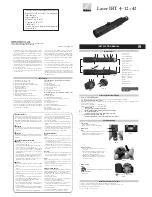
5
the telescope, it should move without resistance and not drift
from where you point it.
4. Aligning the Finder Scope
A finder scope has a wide field of view to facilitate the loca-
tion of objects for subsequent viewing through the main
telescope, which has a much narrower field of view. The find-
er scope and the main telescope must be aligned so they
point to exactly the same spot in the sky.
Alignment is easiest to do in daylight hours. First, insert the
lowest-power eyepiece (longest focal length) you have into
the star diagonal. Then loosen the R.A. and Dec. lock knobs
so the telescope can be moved freely.
Point the main telescope at a discrete object such as the top
of a telephone pole or a streetsign that is at least 200 yards
away. Move the telescope so the target object appears in the
very center of the field of view when you look into the eye-
piece. Now tighten the R.A. and Dec. lock knobs. Use the
slow-motion control knobs to re-center the object in the field of
view, if it moved off-center when you tightened the lock knobs.
Now look through the finder scope. Is the object centered in
the finder scope’s field of view, i.e., on the crosshairs? If not,
hopefully it will be visible somewhere in the field of view, so
that only fine adjustment of the finder scope alignment
screws will be needed to center it on the crosshairs.
Otherwise you’ll have to make coarser adjustments to the
alignment screws to redirect the aim of the finder scope.
By loosening one alignment screw and tightening another,
you change the line of sight of the finder scope.
Once the target object is centered on the crosshairs of the
finder scope, look again in the main telescope’s eyepiece and
see if it is still centered there as well. If it isn’t, repeat the
entire process, making sure not to move the main telescope
while adjusting the alignment of the finder scope.
Check the alignment by pointing the main telescope at anoth-
er object and centering it in the finder scope. Then look
through the main telescope eyepiece and see if the object is
centered. If it is, your job is done. If it isn’t, make the neces-
sary adjustments to the finder scope’s alignment screws until
the object is centered in both instruments.
Note that the image seen through the finder scope appears
upside down. This is normal for astronomical finder scopes.
You can focus the image in the finder scope by turning the
knurled eyepiece housing.
5. Setting Up and Using
the Equatorial Mount
When you look at the night sky, you have no doubt noticed
that the stars appear to move slowly from east to west over
time. That apparent motion is caused by the Earth’s rotation
(from west to east). An equatorial mount is designed to com-
pensate for that motion, allowing you to easily keep
astronomical objects from drifting out of the telescope’s field
of view when you’re observing them.
The equatorial mount enables you to follow, or track, objects
by slowly rotating the telescope on its right ascension axis,
using only the R.A. slow-motion cable. But first the mount
must be aligned with the Earth’s rotational axis.
For Northern Hemisphere observers, this is achieved by sim-
ply pointing the mount’s R.A. axis at the North Star, or Polaris.
It lies within 1° of the north celestial pole (NCP), which is an
extension of the Earth’s rotational axis out into space. Stars in
the Northern Hemisphere appear to revolve around Polaris.
To find Polaris in the sky, look north and locate the pattern of
the Big Dipper (Figure 2, page 10). The two stars at the end
of the “bowl” of the Big Dipper point right to Polaris.
Observers in the Southern Hemisphere aren’t so fortunate to
have a bright star so near the south celestial pole (SCP). The
star Sigma Octantis lies about 1° from the SCP, but it is bare-
ly visible with the naked eye (magnitude 5.5). Consult a star
atlas or other reference book for instructions on polar-aligning
your telescope in the Southern Hemisphere.
Polar Alignment
For general visual observation, an approximate polar alignment
is sufficient. This must be done at night, when Polaris is visible.
The first step is to adjust the latitude (altitude) angle of the
mount’s R.A. axis to the latitude of your observing site.
1. Level the equatorial mount by adjusting the length of the
three tripod legs accordingly.
2. Loosen the latitude lock knob and tilt the mount until the
pointer on the latitude scale is set at the latitude of your
observing site. For example, if your latitude is 40° North,
set the pointer to 40. Then retighten the latitude lock knob.
If you don’t know your latitude, consult a geographical
atlas to find it.
The latitude setting should not have to be adjusted again
unless you move to a different viewing location some dis-
tance away.
3. Loosen the Dec. lock knob and rotate the telescope opti-
cal tube until it is parallel with the R.A. axis. The pointer on
the Dec. setting circle should read 90°. Retighten the Dec.
lock knob.
4. Next, loosen the azimuth lock knob at the base of the
equatorial mount. Rotate the entire equatorial mount in
the horizontal direction until the R.A. axis points roughly at
Polaris. Retighten the lock knob.
The equatorial mount is now polar-aligned for casual observ-
ing. Note that from this point on in your observing session,
you should not make any further adjustments in the azimuth
or the latitude of the mount, nor should you move the tripod.
Doing so will ruin the polar alignment. The telescope should
only be moved about its R.A. and Dec. axes.
Tracking Celestial Objects
When you observe a celestial object through the telescope,
you’ll see it drift slowly across the field of view. To keep it in





















